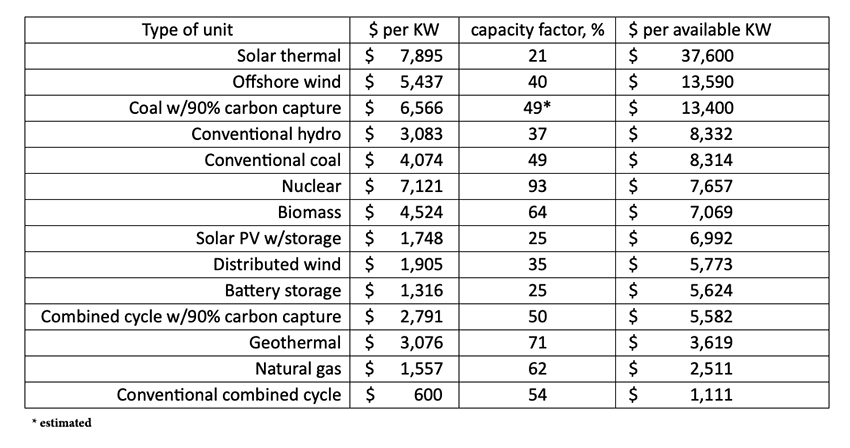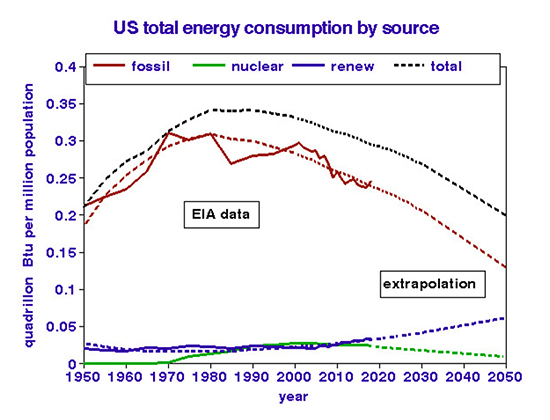“Electricity, the unseen force that powers our modern world, is a beacon of progress and a catalyst for change. It is the lifeblood of industry, driving machinery, and fueling innovation.”
- ChatGPT channeling George Westinghouse
History
Concerns about anthropogenic effects on climate are not new. They may have begun at the Federal level when President Carter installed solar panels on the roof of the White House in 1979 and famously wore a cardigan sweater during a “fireside chat.” Presidents Reagan and George H.W. Bush recognized the issue, but policy actions came later, some of which were rolled back by President Trump. [1]
There are options and factors to consider:
- Power generation without burning carbon – using nuclear fission or solar (thermal, photovoltaic [PV]), wind (land-based and offshore), or geologic/hydrologic sources
- Removing and sequestering CO2 (carbon capture) – from flues or ambient air
- Increasing powerplant efficiency by capturing waste heat
- Reducing natural sources or preventing leaks of greenhouse gases - Methane (CH4), Nitrous oxide (N2O), and sulfur hexafluoride (SF6) from end uses.
- Cost
- Implementation time required.
- Capacity factor (peak vs. base load) - the fraction of actual power produced relative to the design value. It is reduced by downtime for maintenance, variations in energy input such as solar or wind, and fluctuations in daily and seasonal demand.
- Difficulties in siting (land requirements, zoning, permitting).
Cost
I compare capital costs of various sources of electricity generation, estimating the costs of power that might be available long-term divided by the capacity factors.
 Gas has the lowest capital and operational costs, requiring no ash disposal or the need to remove sulfur oxides from flue gases. It requires no fuel preparation, and boiler maintenance is low. These factors likely contributed to the current predominance of natural gas as the electric utility fuel of choice, having partially displaced coal.
Gas has the lowest capital and operational costs, requiring no ash disposal or the need to remove sulfur oxides from flue gases. It requires no fuel preparation, and boiler maintenance is low. These factors likely contributed to the current predominance of natural gas as the electric utility fuel of choice, having partially displaced coal.
Capital costs of electric power generation
- Solar thermal plants are the most expensive and suffer from intermittent sunshine.
- Carbon capture has yet to be demonstrated at a sufficiently large scale.
- Untapped geothermal and hydroelectric sites are very scarce.
- Nuclear power is available continuously but suffers from public fear of radiation and concerns about waste disposal.
- Offshore wind power is limited geographically.
- Data on combined cycle power plants are limited, but the concept offers substantially greater thermal efficiencies.
- The significant difference between offshore and land-based wind systems illustrates the high costs of aesthetics in placing these systems. Not In My Backyard (NIMBY) is very much alive.
These figures are roughly current, but in 2000, coal accounted for about 52% of capacity, gas supplied 17%, nuclear was 21%, and contributions from renewable sources were negligible. The major change has been replacing coal with gas and retiring about 11% of coal-fired units capacity in 2000.
Costs of capacity-adjusted power for the remaining types of systems range from $1,111 to $8,332 per KW, with conventional coal firing near the head of the list. There appears to be little penalty associated with carbon-free systems, notwithstanding that these are only estimates. For a 1000 MW plant, capital costs range from about $1.3 billion to $7.9 billion, plus land acquisition costs that could be appreciable for solar power. CO2 disposal is not included in carbon capture costs.
Choosing among these alternative power production systems involves capacity factors. The nuclear and carbon capture technologies allow base-load operation and could be combined with either solar photovoltaic or land-based wind systems to accommodate peak power demands. Depending on geography, combining solar and wind systems may be advantageous since bright skies tend to occur during slow-moving high-pressure systems, while strong winds occur with frontal passages.
Land Area Requirements [2]
About 500 acres are required for a new 1000 MW coal-fired power plant; about 5000 acres would be needed for a comparable solar PV generating station. The largest solar facility in the US has a peak capacity of 747 MW and covers 5700 acres in California. Several multi-unit “wind farms” in the US generate thousands of MW-hr of electricity, but as a rule of thumb, wind power requires about 2 acres per rated MW. Wind energy generated 8.4% of the total power in the US in 2020 on 2.2 million acres; scaling this up to 100% power would cover the entire state of Ohio. Offshore wind turbines can be as large as 12 MW, but it is challenging to imagine similarly large wind farms offshore.
There are also questions of scale. Conventional fossil-fueled power plants are impractical for > 100 MW applications, especially not for coal, because of the logistics of bringing in coal and hauling away ash. By contrast, “micro” gas turbine generators are available down to 100 KW or less.
Timing Considerations
Global warming is time-sensitive since CO2 emissions may stay aloft, trapping heat for centuries; it’s essentially a 1-way trip. Cost-benefit analyses of emission reductions, the “gift that keeps on giving,” should be integrated over very long periods globally. Cost-benefit studies of global warming damages reported a range of $30-150 (median = $67) per ton of CO2 added and integrated over time.
Coal firing emits about 2.5 tons of CO2 per MW-hr, for which estimated damages would be about $170 per MW-hr. The retail price of electricity in the US is about $110 per MW-hr; paying for these damages upfront could increase the price of power by 150%. The details of these calculations are far beyond this rudimentary analysis. Still, the point is that delay in retarding the accumulation of CO2 can be very expensive to society globally.
New Technologies
Nuclear power suffers from largely unwarranted public fears and concerns about waste disposal that will be difficult to overcome in the US anytime soon. Small-scale nuclear power has been utilized safely aboard ships and submarines for decades, and the Department of Energy has been pursuing this application for land-based power reactors.

Carbon capture offers a way to continue burning fossil fuels with minimal emissions of CO2. Only one powerplant has operated such a system, but that CO2 was used for oil extraction nearby and not sequestered. This plant was shut down in 2020 because of falling oil prices. Seven coal capture projects are under consideration; none are operational, and one has already been canceled. EPA’s carbon-capture press release stated that their proposed regulation would save 617 million tons of CO2 through 2042. But this amounts to 31 million tons of CO2 annually, comprising only 0.1% of annual global emissions.
The combined-cycle concept may be the unsung hero of power system development. The “combination” uses a steam turbine to utilize the thermal energy discharged from a gas turbine - essentially, the hot exhaust gas spins an additional turbine. Efficiencies exceeding 60% have been reported. The largest such installation is rated at 3800 MW on only 220 acres and operated at 45% capacity in 2021. Note that gas turbines can run on a variety of fuels, from hydrogen to natural gas to medium-weight fuel oil and perhaps even cooking oil. The ”dream” technology for base load operation could be combined-cycle with carbon capture, but only small-scale (< 100 MW) systems have been demonstrated.
Where do we go from here?
 The analysis above was limited to the current status of electric power, but there are also substantial non-electric sources of CO2 to consider. I used historical data from the Energy Information Administration EIA based on total consumption data by fuel type and extrapolated the future using statistical curve fits.
The analysis above was limited to the current status of electric power, but there are also substantial non-electric sources of CO2 to consider. I used historical data from the Energy Information Administration EIA based on total consumption data by fuel type and extrapolated the future using statistical curve fits.
- The EIA data show essentially constant usage at about 100 quadrillion BTUs since 2000, leading to decreasing use per capita due to population growth.
- Usage of renewables increased steadily, reflecting tradeoffs from fossil sources.
- Nuclear energy is predicted to fade away in the US, likely because of facility retirements and public opposition.
- Total energy consumption per capita is predicted to decline substantially from its peak in 1980, presumably because of improving end-use efficiencies such as reduced vehicular fuel consumption.
Renewable sources have a very long way to go before fossil energy can be completely phased out to provide a carbon-free economy. Given the current bad rap that nuclear energy continues to endure, we must find ways to use and decarbonate fossil energy emissions and continue promoting solar and wind power to handle peak loads. Combined-cycle with carbon capture may be our best base-load option, but it, too, has a long way to go. The US consumes less than 20% of global energy and emits about 15% of global CO2, and the twelve nations with the largest greenhouse emissions account for only 48% of the worldwide total. The US cannot go it alone.
The underlying messages for the US may be to soak up the sun, harvest the wind, export our combined-cycle technologies, and work towards keeping the world’s coal in the ground. Nevertheless, a zero-carbon emission world remains an impossible dream.
Full disclosure: I was involved with gas turbines during my early engineering career.
[1] Rich, N. Losing Earth, A Recent History. Farrar, Straus, and Ginoux, 2019. ISBN 9780374191337
[2] ChatGPT provided these numerical estimates. I compared several replications to check stability and used them here to illustrate likely trends.



